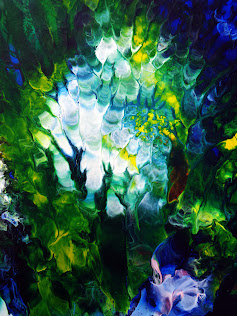Come, let me give your eyes rest.
"Look deep into this image painted by one whose eyes have long
sought for peace and rest through some connection with Nature."
Dr Abe V Rotor
Come, let me give your eyes rest, in acrylic (33.5" x 24") by AV Rotor 2025
Painting on display at the Living with Nature Center, San Vicente, Ilocos Sur
Are your eyes tired of too much exposure on the computer, day and night, hour after hour, rushing up school assignments, work-at-home deadlines, tracking down news here and abroad, or simply playing games which is actually a straining pastime?
Are your eyes tired from heavy schedule in office, at the workplace, driving through heavy traffic beating rush hour and the Bundy clock, for hours, going out and back home, at daybreak and after work, and doing errands in between?
Are your eyes tired of too much drama on stage and screen, audio-visons virtually without end, fiesta or no fiesta, searching for apparition in the sky, braving the camera and floodlights, looking into the lens for the unseen, and now, with AI magical power?
Are your eyes tired of blinding and blinking lights on the highway complex of vehicles, floodlights and billboards, in restaurants and bars, even in the park you think relaxing to spend a weekend with your family, or simply alone for reflection?
Are your eyes tired of reading novels, printed or in e-book versions by your favorite authors like Hemingway, for contemporary realism; Pasternak, for refined radicalism; Mark Twain, for boys' adventure; Jules Verne, for prototype futurism?
Are your eyes tired of the imagery of Future Shock and Eco-Spasm by Alvin Toffler, of Uncle Tom's Cabin in the age of slavery in the US, of Ann Frank's Diary of a lonely and frightful world during WW II, of Orwellian Big Brother syndrome in "1984"?
Are your eyes tired, seeing not only real vision but after-visions accumulated through hours and hours of concentration in school, office, home, and residues of visual experiences surreptitiously stored in your Jungian psyche?
Look deep into this image painted by one whose eyes have long sought for peace and rest, for connection with Nature in the sky and into the deep, in the microcosm of a leaf, filaments of algae, rootlets, buds, myriads of unseen mysteries of creation.
And in seeing all these, you may find your way back to the beauty, innocence and joy, to the simplicity and harmony of life and living. ~
Details of painting, Come, let me give your eyes rest, by AV Rotor 2025.
Left, author and artist (right) poses with a fellow senior citizen and friend,
Gerry Singson. Students from the University of Northern Philippines on a
study tour at the Living with Nature Center. The painting cautions those on
the "busy lane" to slow down a bit and reflect on the lighter side of life. ~



























.jpg)













